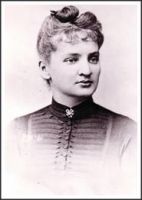Bronisława Dłuska
»In the shadow of the great sister«
Why I think this woman as an important person?
Bronisława Dłuska at the expense of enormous sacrifice and self-denial completed her medical studies at the Sorbonne. She was persistent in pursuing goals despite enormous obstacles and became a great doctor and social worker. She was the founder of a sanatorium, and preventorium of anti-tuberculosis. Her enormous fortitude was a great support to her famous sister - Maria Skłodowska-Curie, and after the death of Maria she continued the joint work. She was an extraordinary person and very unjustly her merits and achievements are ignored. I suspect that if she wasn’t the sister of the great Maria she would find a proper place in history.
Biography
Bronislawa Dłuska was born in the teacher family of Skłodowski. She had to grow up very quickly due to the tragic death of her older sister Sophie (1876) and the death of her mother of tuberculosis (1878)). 13-year-old Bronislawa was forced to mother her siblings. These problems did not stop her from finishing high school in 1882 with a gold medal. She dreamed of medical school (in Warsaw inaccessible for girls). In addition to household chores, attending diligently to the so-called „Flying University” (beautiful chapter in the history of contemporary Polish), taught poor girls to read. At the same time she gathered money to study at Sorbonne, making money by tutoring. At the age of 19, she went to study medicine in Paris, which she finished in 1890 with very good results as a gynecologist and obstetrician. She married Kazimierz Dłuski (political exile, politician and doctor). Under Bronisława’s pressure her younger sister, Maria, came to Paris in 1891, and thanks to her care Maria began studies at Sorbonne. Bronisława ran a medical practice and the main clientele were workers’ families. She worked very hard and despite the difficult financial situation Dłuski’s Paris apartment was open to polish immigrants and played the role of a culture salon. In 1898 Bronisława and Kazimierz went to Zakopane (Kazimierz without the right to return to the Russian partition), where they created a sanatorium for people with lung disease such as tuberculosis (the slow death of the mother made a deep cut in the Bronisława’s psyche). In 1919, Bronisława’s husband became a member of the delegation to the Versailles Peace Conference. The creation of the Polish state allowed Bronislawa to return to her beloved Warsaw. In the suburban Anin together with her husband she opened anti- tuberculosis preventorium. Life treats her cruelly. In 1903 her 6-year-old son dies of meningitis, in 1922 her daughter Helena committed suicide, (born in 1892 a well known mountain climber, crippled after a tragic accident in the mountains), despite of all these tragic events she was always a huge support to the family. Especially to her beloved sister Mary, Bronisława is at her side after the death of Pierre Curie in 1906). In 1911, and when the seriously ill Maria receives the second Nobel Prize, her sister cares for the dying of radiation sickness Maria. Thanks to her initiative Maria Skłodowska-Curie decided to set up the Radium Institute in Warsaw (the second after Paris), which was also a center to research and treatment of cancer. For the poor, after years of captivity, Poland it was a huge investment. Maria raised funds abroad (among others in America), Bronisława organized a committee in Poland called „National Gift for Marie Skłodowska Curie,” which collected funds - symbolic bricks with the image of the Nobel Prize winner were sold. From the government she received some land in Warsaw for the construction of the Institute (the foundation stone was placed in 1925). The institute was built under Bronisława’s supervision and she also supervised the preparation of future staff. Despite the next tragedy (the death of her husband in 1930), and the crisis in the 30s, the official opening of the hospital Radium Institute took place on 29th of May, 1932, and Bronisława became the first director of the Institute. When the seriously ill Maria died on the 4th of July, 1934 year, the sister continues her work. She died five years later, April 15, 1939.
Bibliography
- Lemire L, Maria Skłodowska –Curie Świat książki Warszawa 2004.
- Brian,D, Rodzina Curie wyd. Amber 2006
- Curie, Eve: Maria Curie. PWN 1997
Picture source
The collections of the Maria Sklodowska Curie Museum in Warsaw, Rights: The copy of the photo-owned by museum and the consent to publish on the website www.unless-women.eu issued by the Maria Sklodowska Curie Museum in Warsaw .




